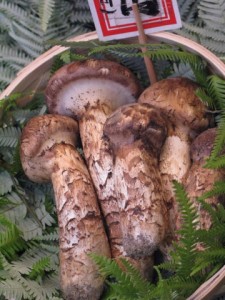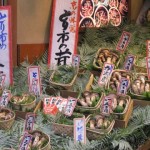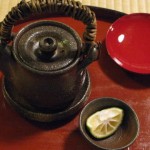It’s been busy months, travelling and participating some of the most memorable Conference and events in my life both domestic and abroad, including the one at CIA’s World of Flavor Conference: Japan at Greystone, CA campus. It was an absolute pleasure and honor to be a moderator and presenter for many General Sessions and seminars at this Conference, and work with great chefs who flew from Japan. Now I am back to my blog page with an article which should have been posted a month ago.
It is Matsutake mushroom…and I am sorry that the season was gone for over a month! Before I left for Japan at the beginning of October I received a couple of e-mail messages from Susan and Michael – a mushroom hunter couple who comes every Wednesday to sell wild mushrooms at the Greenmarket in Union Square here in New York City. The message carried the good news that long waited matsutake mushrooms from upstate were available at their stand. Unfortunately I missed to try them for three consecutive weeks because I was in Japan. So, when I saw matsutake mushrooms at food markets in Tokyo and Kyoto my heart was dancing.
Today matsutake mushrooms from abroad – China, Korea, Canada,…- dominate the market in Japan. They are in general larger in size and topped with widely opened caps. The price is one third of the Japanese domestic variety.
After spending some time in Kyoto without spotting any domestic matsutake mushrooms even in that center of Japanese cuisine, one day I finally encountered beautiful and aromatic matsutake mushrooms from Tanba, which were beautifully presented in baskets (photos). Tanba is located north west of Kyoto and is one of the most praised matsutake harvesting regions in Japan. Unlike imported, over-sized mushroom, Tanba variety is only about four inches long and are capped with a tightly closed cap, concealling its aroma. Tanba is valley, surrounded by mountains. The temperature difference between the day and the night is huge, humidity is high and the soil is fertile. This soil and climate also produce some of the best black soybeans, chestnuts and rice as well.
Since the price of matsutake mushroom is very high (a good quality, large thumb size piece with a closed cap can cost $50 a piece), we have developed ways to enjoy this seasonal delicacy – stretching its aroma, taste and texture in dishes like dobin-mushi (a soup dish) and matsutake-gohan (a rice dish). Dobin-mushi is a soup that is served in a special pot with a little sake cup like vessel. Pictured here are some of the dobin-mushi dishes that I enjoyed in Kyoto. In the soup was a piece of hamo (an eel like fish whose head is long and pointed with teeth appearing like thorns), a piece of shrimp, gingko nuts, some greens and thinly sliced matsutake mushroom. The soup is infused with mushroom flavor and aroma. It is elegant but powerful. Kabosu (a citrus fruit) accompanies the soup.
Here is how to enjoy dobin-mushi; pour some soup from the pot into the tiny cup, squeeze little kabosu juice into it and enjoy; then, open the lid and with your chopsticks in it to pick up any treasure in the soup; after enjoying it, pour the second batch of soup into the cup; you repeat this process until you finish the soup and inside treasures. You can enjoy this soup in your kitchen without owning a special pot. I will post the recipe next week (for your next year’s dobin-mush venture!).






